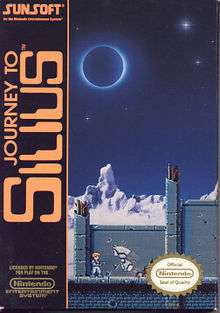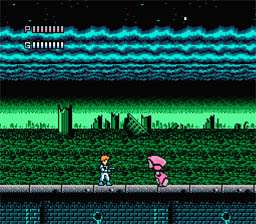Journey to Silius
| Journey to Silius | |
|---|---|
 North American NES box art | |
| Developer(s) | Sunsoft[lower-alpha 1] |
| Publisher(s) | Sunsoft |
| Composer(s) | Naoki Kodaka |
| Platform(s) | NES |
| Release | |
| Genre(s) | Run and gun |
| Mode(s) | Single-player |
Journey to Silius, known in Japan as Rough World (ラフワールド Rafu Wārudo, stylized as [rʌf] WORLD),[lower-alpha 2] is a side-scrolling run and gun video game developed and published by Sunsoft for the Nintendo Entertainment System in 1990.
Journey to Silius was originally based on the 1984 film The Terminator, but the licensing rights to the film were lost during development. The graphics and storyline were altered to accommodate this change.
Gameplay

The player controls Jay McCray, as he goes on a mission to defeat the terrorist group responsible for his father's death. There are five stages, consisting of the ruins of a space colony, an underground concourse, the enemy's hideout, a flying spaceship, and a factory. The player must fight his way through an assortment of robotic enemies and security systems in order to reach the end of each stage and fight the stage's boss.
The controls follow the standard conventions of other side-scrolling action games for the NES. The character can lie down, but he can only aim his gun left or right. In addition to the default handgun weapon, the player can switch to one of five additional weapons that can be procured throughout the course of the game - which are a shotgun, a machine gun, a homing gun, a laser rifle, and a grenade launcher. Each of these special weapons consumes the player's Gun Energy gauge and once it runs out, the player will automatically revert to the default handgun. The player can replenish Jay's health and ammo by retrieving energy capsules dropped by defeated enemies. After the fifth and final stage is completed, the credits are shown, and the player will restart the game on the first stage.
Plot
In the year 2373 of the new space age calendar, overpopulation of Earth has led to increased demand for emigration to space colonies. Jay McCray, the son of a scientist responsible for development of space colony #428 in the Silius Solar System (SSS), prepares to move there in order to follow in his father's footsteps. However, the space station is obliterated in an explosion, killing the entire research team and destroying all data on board.
In his father's home, Jay discovers a floppy disk containing not only the complete SSS colony plans but a personal message from his father asking that he complete the projects should terrorists succeed in destroying the colony. To protect the colony plans and to avenge his father's death, Jay sets out to fight the terrorists responsible for the space colony's destruction.[3]
Development
Journey to Silius was originally conceived as a game based on the 1984 film The Terminator.[4] However, Sunsoft lost the license during development and as a result the plot and graphics were altered before release.
The American version features a different design for the player character from the one used in the Japanese and European versions (which depict the main character in a futuristic armor and helmet, instead of having his head exposed). A pre-release build of the Japanese version, simply titled Rough, featured the same player character design used for the retail release of the American version.[5]
The soundtrack was composed by Naoki Kodaka. Most NES composers would use the digital channel for sampled drums and the other channels for melodic content, but for Journey to Silius, Kodaka, with the programming assistance of Nobuyuki Hara, Shinichi Seya, and Naohisa Morota used the digital channel for a sampled bassline, and the triangle channel for a kick drum.
Ports
Rough World was re-released in Japan in a two-in-one compilation for the PlayStation titled Memorial Series: Sunsoft Vol. 5, which also included Hebereke.
Reception
While the game itself never received wide acclaim in Western markets, the music has been widely praised and has been subject of numerous remixes, such as "JURN3Y 2 51L1U5" project.[6]
Notes
- ↑ Developed under the shell corporation Tokai Engineering[1]
- ↑ The other releases have "JOURNEY TO SILIUS" printed in the sound test menu, but the Japanese release has "ROUGH" ([rʌf]); see Development for more details. Because of this, "Rough World" would be appropriate.
References
- ↑ Gancer, Stefan (18 August 2017). "The History of SUNSOFT Part III: The Golden Age Part 1". VGArc. Retrieved 18 August 2017.
[A]ccording to Gimmick! creator Tomomi Sakai, Tokai is just a dummy company, like Konami’s Ultra and Palcom brands, created to circumvent Nintendo’s rules restricting the number of games a developer could publish for the Famicom/NES in a year. Former Sunsoft programmer and Trip World creator Yuichi Ueda, Blaster Master creator Kenji Sada, and current Chief Director of SUNSOFT Shigeki Shimizu confirm this. Tokai is a dummy company.
- 1 2 3 4 Journey to Silius Release Information for NES, GameFAQs, archived from the original on 2012-09-02, retrieved 2013-09-14
- ↑ Journey to Silius Instruction Booklet, Sunsoft, 1990
- ↑ "Pak Watch - Terminator". Nintendo Power. No. Vol. 7. July–August 1989. p. 86.
- ↑ Famicom Journal (ファミコン通信, Famicom Tsūshin) (Number 9). April 27, 1990 http://www.chrismcovell.com/secret/FC__1990Q2.html. Missing or empty
|title=(help) - ↑ http://silius.olremix.org/songs.html